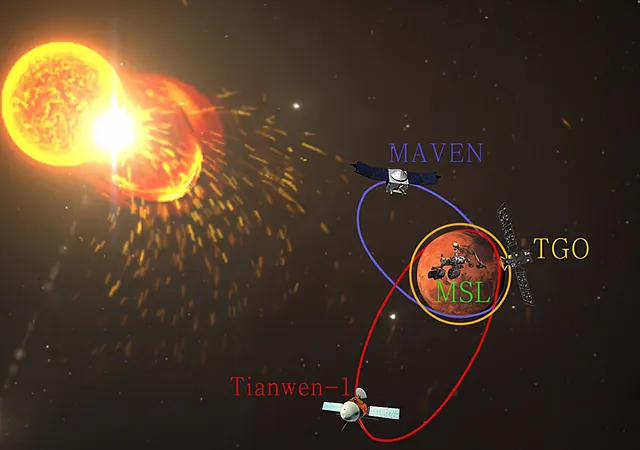
Breakthrough in Space Science: First Ever Complete Energy Spectrum of Solar High-Energy Protons Unveiled in Martian Space!
2024-11-22
Author: Ming
Introduction
Scientists are raising the stakes in our quest for understanding the cosmic environment of Mars by constructing the first complete proton energy spectrum observed during a solar eruption in Martian space. This groundbreaking study not only enhances our comprehension of radiation around the Red Planet but also marks a significant leap forward for the future of space exploration.
Research Collaboration
Conducted by a team of researchers from the University of Science and Technology of China, the Institute of Modern Physics of the Chinese Academy of Sciences, the Lanzhou Institute of Physics, and the University of Kiel in Germany, this pioneering research was published as a cover article in Geophysical Research Letters. The collaboration emphasizes the global effort in advancing space science.
Understanding Solar Energetic Particle Events
Solar energetic particle (SEP) events, stemming from violent solar eruptions, are notorious for their destructive potential, significantly increasing the flux of high-energy charged particles in space. These events pose severe threats to spacecraft and astronauts alike. Unlike Earth, which is sheltered by a robust magnetic field and a protective atmosphere, Mars has a much thinner atmosphere and no magnetic shield. This vulnerability makes Mars an excellent point of study for understanding the effects of high-energy cosmic radiation.
Importance of MEPA in Martian Research
This research takes on added importance as we look to future missions to Mars. With China's Tianwen-1 orbiter beginning its scientific orbit around Mars in November 2021, its Mars Energy Particle Analyzer (MEPA) has been at the forefront, measuring particle flux in a wide energy range from 2–100 MeV. The data collected significantly bolsters our understanding of high-energy protons in Martian space, providing essential information that informs this study.
Milestone Event and Observations
The milestone event happened on February 15, 2022, when MEPA captured an SEP event that was exceptionally intense and energetic. Impressively, this event was also detected by several other instruments, including the European Space Agency's Trace Gas Orbiter, NASA’s Mars Atmosphere and Volatile Evolution Orbiter, and even the Curiosity rover on the Martian surface. This marked the first instance where such diverse instruments collectively observed a SEP event on Mars, showcasing the collaborative power of international space research.
Constructing the Proton Energy Spectrum
Utilizing a mix of data from multiple detectors, researchers meticulously constructed the proton energy spectra. The low- and medium-energy proton spectra were sourced from Tianwen-1 and MAVEN, while the high-energy proton flux was derived through a combination of observations from Curiosity alongside simulations of particle transport in the Martian atmosphere.
Achieving a Comprehensive Understanding
By fitting these observed and derived fluxes across different energy levels, researchers successfully pieced together a comprehensive proton energy spectrum for the SEP event that spans a daunting range of 1 to 1000 MeV. This remarkable achievement enabled them to calculate the radiation dose resulting from the event, both in Martian orbit and on the planet's surface, confirming alignment with actual dose measurements. Thus, they validated the reliability of the Tianwen-1 MEPA data and the accuracy of the Martian radiation transport model used.
Implications for Future Research
This formidable study not only serves as a reference point for future research into similar space weather phenomena but also emphasizes the critical need for ongoing and coordinated radiation monitoring efforts on Mars. With the potential for manned missions to Mars on the horizon, understanding the radiation environment is of utmost importance for astronaut safety.
Conclusion
The implications of these findings are monumental, propelling the space science community toward safer and more informed exploration of our neighboring planet! Stay tuned as we dive deeper into the cosmic mysteries of Mars!




 Brasil (PT)
Brasil (PT)
 Canada (EN)
Canada (EN)
 Chile (ES)
Chile (ES)
 España (ES)
España (ES)
 France (FR)
France (FR)
 Hong Kong (EN)
Hong Kong (EN)
 Italia (IT)
Italia (IT)
 日本 (JA)
日本 (JA)
 Magyarország (HU)
Magyarország (HU)
 Norge (NO)
Norge (NO)
 Polska (PL)
Polska (PL)
 Schweiz (DE)
Schweiz (DE)
 Singapore (EN)
Singapore (EN)
 Sverige (SV)
Sverige (SV)
 Suomi (FI)
Suomi (FI)
 Türkiye (TR)
Türkiye (TR)